Getting To Grips With Your Spice Collection
Next in my series getting to grips with your ingredients, I thought I’d focus on spices. We all have them, I know there are so many that we buy for one recipe never to use again, and believe it or not, I seem to have even more of them that I do cooking oils or Asian ingredients! So, below I’ve run through my spice collection, noting who are my favourite suppliers, which you can toast and grind yourself (and don’t worry, I’ll tell you how to do that too!), and most importantly, give you some recipe inspiration so that nothing needs to go to waste!
Shall we start with what seems like the most basic spice, but there are actually endless variations of? Dried chilli. To start off, basic chilli powder, which tends to come in three variations: hot chilli powder, mild chilli powder, and chilli powder like the one I have above, just marked as ‘chilli powder’. The first two do what they say on the tin, and generic ‘chilli powder’ varies in flavour or heat depending on the supplier. I buy ones that are on the milder side (but still with a bit of gentle heat). While my tub is from Spice Mountain (where I buy my spices when I’m in London, they’re always of great quality and you can find them in Borough Market), the spice inside is from Absolute Spice, which is where I buy my spices online. They’re great value, but they come in plastic bags not tubs, so more of a refill destination. Another chilli powder I’ve got here is Ancho Chilli Powder. It’s a bit smokier, bit earthier and I find it does not pack much heat. It’s more common in Mexican cooking, in chilli and paired with chocolate. To be honest, I don’t think I’ll be replacing this tub.
Usually categorized differently from chilli is paprika, but it does in fact come from chilli peppers. You’ll get the standard stuff in supermarkets called ‘paprika’ which varies and is annoyingly unspecific when it comes to flavour, ‘sweet smoked’ and ‘hot smoked’, which I prefer as you know if you’re adding it for a smoky flavour, or for heat and a smoky flavour to your dish. I buy La Chinta because the tubs look pretty and authentic, but if not whichever tub from one of my preferred brands I usually reach for. Barts do really great quality supermarket spices, and their bottles helpfully have a double cab for both sprinkling the spice out, and getting in there with a measuring spoon.
In other chilli news, Cayenne Pepper is what you use if you want to add a lot of heat to something without having to add loads of spice which will also flavour the dish (for example, there is a sprinkling in my Classic Cheese Straws recipe to give it a bit of a kick, but without a chilli flavour), and crushed chilli flakes (called red pepper flakes in America) are good for marinades where the flavour and heat can really soak in, and pasta dishes where you want a slow building heat, some flavour, and for them to look pretty. I also keep a jar of Japanese Togarashi, which is a quite spicy and pretty blend you usually find as a sprinkling on Udon, and is an ingredient in a family favourite chicken recipe so we use it a fair bit. It is a blend of chilli flakes and various other spices depending on where you get it from, but it usually includes sesame seeds, Sichuan pepper, dried citrus peel, poppy seeds, hemp seeds, ginger, garlic, shiso, and crumbled nori.
Some recipes that use some of these chilli powders and spices: Indian Spiced Leftover Summer Vegetable Fritters, Homemade Chicken Fajitas, Indian Spiced Potatoes, or Easy Avocado Spaghetti.
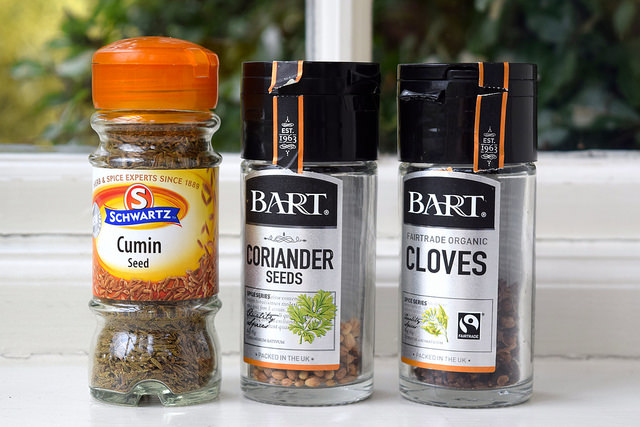
Okay, so I know it sounds a bit intimidating, but let us talk about whole spices. We’re starting with three here, because here are three that you can easily toast and grind yourselves. Lots of chefs say you get a better flavour doing it yourself, but let us be honest, I mostly buy them ready ground, and I use whole spices whole in cooking. Here we have one of my all time favourites, cumin (smoky, deep and found in everything from Indian to Middle Eastern to Mexican cooking) which I like to finish spiced soups with, or add a bit of texture to spiced potatoes with. Coriander seeds are fragrant, and are wonderful tossed in with some roasting squash, and whole cloves basically smell of Christmas. I use them to stud my Christmas ham, and to stud fresh oranges with for fragrant Christmas decorations/ mulled wine flavourings.
If you do want to grind your own spices, I know some people have special spice grinders or use a coffee grinder. I just go for my trusty Cole & Mason Mortar and Pestle. Just add your whole spices to a dry frying pan and set it over a medium heat, tossing every minute or so. If they’re not already brown, your spices should go golden, some will pop a little (like coriander seeds), and they will all smell wonderfully fragrant. Stop once the smell hits you, as burnt spices are no good spices. Then grind them into a powder.
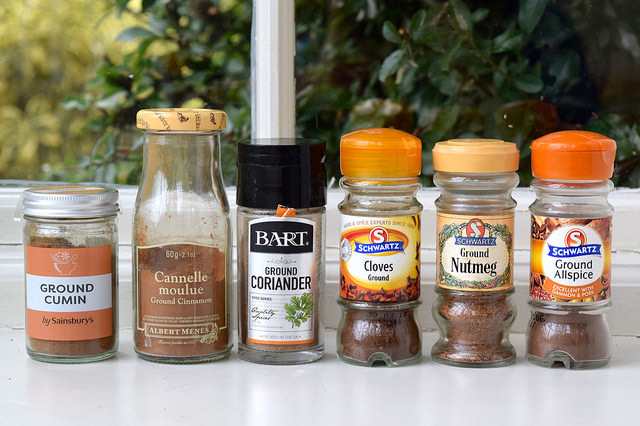
Moving on from that, to ground spices. From left to right, you can use ground cumin wherever you’d use cumin seeds. Most of us think of sweet applications like cinnamon rolls, or stirring a spoonful into hot chocolate for cinnamon, but it is also common in Middle Eastern savouries and Indian curries. To me ground coriander, which I find is earthier and less fragrant than its whole counterpart is good again in curries, or in these Indian Spiced Potato Wraps with Easy Raita & Spicy Slaw. Ground cloves and ground nutmeg are both very strong, overpowering spices that I tend to use sparingly at Christmas time, for example in my Orange & Festive Spice Biscuits. Allspice is a trickier one, it does not really have a flavour I could describe, except that it is very unique and works well to add some oomph to barbecue sauces. My Mum’s chicken drumsticks (I will get around to posting the recipe here for you all someday) would not be the same without it, and I always add a pinch to any savoury meat marinade where I’ve made pomegranate molasses the star.
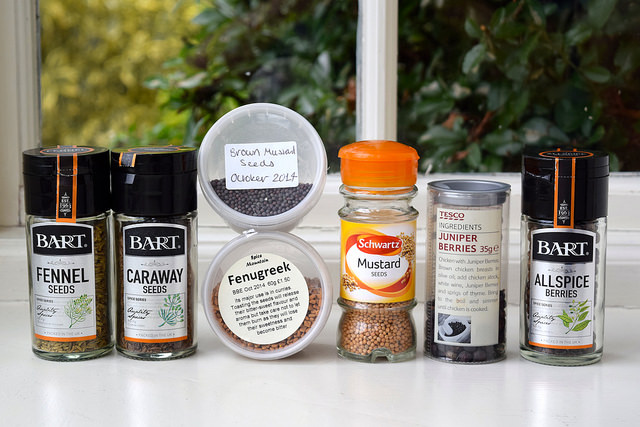
On to the rest of the whole spices. I love fennel seeds, and to me they always sing in dishes with ground pork. If you like pork and fennel sausages, you’ll see how their slightly aniseed note really makes the meat sing. Caraway is a bit similar in flavour, but a lot less distinctive. I like it in cabbage dishes, such as my Shredded Sprouts with Pancetta and Chestnuts. I’ve put these down here with the other whole spices and away from the cumin (though all three seeds look to the eye very similar) as they’re more commonly used whole than ground.
Fenugreek is a very odd seed with what I don’t see as much of a flavour. I got it for a curry and have not used it since – if anyone reading this is a fan, I’d love to hear how you use it. Looking at the rest of the collection, I mostly use brown and yellow mustard seeds, juniper berries and allspice berries in pickles, though the mustard also is commonly used in curries, and can be used along with a good quality vinegar to make wholegrain mustard at home. Juniper is actually what gives gin its distinctive flavour, so I always use it wherever I add gin to my cooking to boost the flavour, such as in my Gin & Dill Cured Salmon. Also, to really boost the flavour in a gin and tonic, toast and very lightly crush about two dried juniper berries and add them to your drink. Allspice is a relatively new one for me, as I’ve been experimenting with perfecting homemade rollmop herring. So far I’ve found that it is essential for its distinctive flavour.
Oh, and you may notice that my brown mustard seeds are hideously out of date. Dates do matter with spices; they can loose their flavour and perfume, or go stale over time. As a rule of thumb, I use my nose to see if something is still okay. Whole spices can be refreshed with a flavour boost a bit by toasting them.
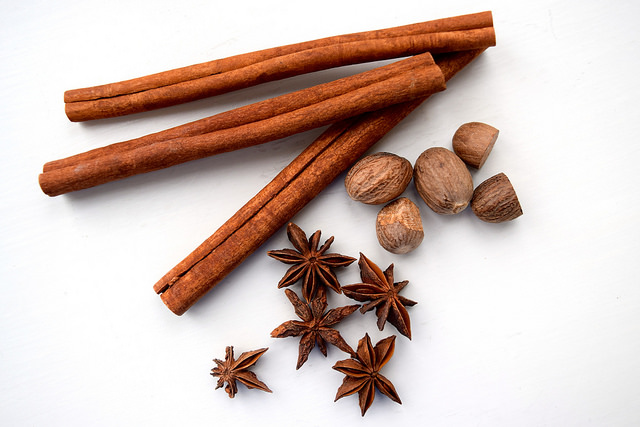
Before we move off of whole spices, some of the bulkier ones. I’m obsessed with how pretty star anise are, and they have a really unique, exotic perfume. I use them in mulled wine, in pickles, and in pots of rice along with a bit of cinnamon stick to add a whisper of flavour. Cinnamon sticks again are essential in mulled wine, and in some curries. You can infuse flavour from both spices by warming them gently and letting them steep in liquid. You can buy a custom cinnamon grater to get ground from the stick, but I’m honestly of the opinion that life is too short. The third spice here is nutmeg. I feel freshly ground nutmeg always has the best flavour, and a whisper over the top is on beautiful on very savoury, autumnal dishes like homemade lasagnas and squash bakes.
I can’t believe it, but I’ve actually forgotten to photograph my all time favourite spice: green cardamom. I don’t really use black cardamom pods so I can’t really speak for them, but the green pods carry such a unique and exotic perfume I can’t help but be entranced. You do get them flavouring rice and some curries, but I love them mostly in sweets. They also infuse beautifully, (lightly crush the pod to release the black seeds) both in milky, sweet teas and cream or fruit desserts, like my Forced Rhubarb and Cardamom Compote. You can also crush these black pods for baking, in gently scented biscuits for example. Be careful with the ground version though, as too much can make things taste rather medicinal.
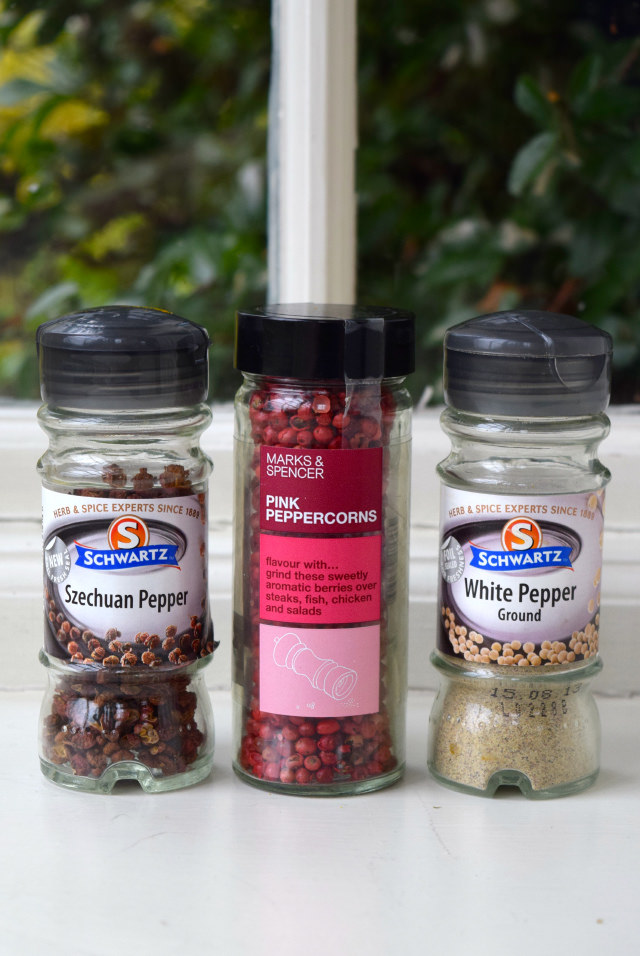
Now let us talk about peppercorns. Obviously I have the black ones elsewhere in the kitchen (both in a grinder and a little jar to add to pickles and infusions), but these are some more unique ones for different dishes. Szechuan, which is from Asia is very distinctive, and very spicy. Use at your own risk in Szechuan cooking. Pink peppercorns are a bit more like the ubiquitous black, but a little sweeter and with a bit more perfume. Try them in sweet applications such as freshly ground over fresh strawberries in summer. I’m experimenting with putting them in cookies. Ground white pepper is yes, that horrid stuff from the school lunch table, but is also useful in marinades where you want the flavour without lots of black specks, a little goes a long way, and it is an essential flavour profile in a lot of Asian cooking, which is mainly where I use it.
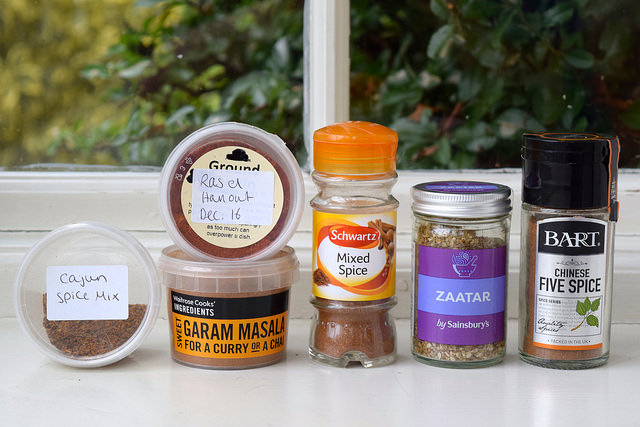
Spice blends are very personal. You can mix them yourself from other spices you may have (Google is your best friend here), but if you play around you can usually find our favourite brands to suit your personal tastes. Cajun spice mix is an essential for me: I use it as the main flavour base when I make a veggie chilli, and it is also a great marinade for things like barbecue prawns. Ras el Hanout is a Middle Eastern mix with paprika, cumin and dried rose petals among other ingredients (I ground and mixed my own from the recipe in The Palomar Cookbook) that I am still experimenting with, and Garam Masala is a sweet Indian blend that works both in chai or in some more savoury applications, such as an Easy Coconut Kedgeree. Mixed Spice is another I always associate with basically being the smell of Christmas. It is a blend of cinnamon, all spice and nutmeg usually, and I use it both in Christmas biscuits and cakes, and in my Mama’s Lockshen Pudding.
Za’atar is the Middle Eastern spice of fashion, and it is a wonderful sprinkle and marinade ingredient. I’ve tried loads and Sainsbury’s (in their sexy new jars) and Steenbergs are my favourites. Sprinkle it over homemade labneh cheese with a good glug of extra virgin olive oil, or simply just coat some meat in it before throwing it on the barbecue. They’re all different, but they all at least have sumac, sesame seeds and dried za’atar leaf in them. Finally, Chinese five spice. Smell it and you’ll be transported to a Chinese restaurant. It’s rather strong and aromatic, and it usually contains cinnamon, cloves, fennel seed, star anise and szechuan pepper. I always rub it on roast duck or duck legs, which is then great shredding into wraps.
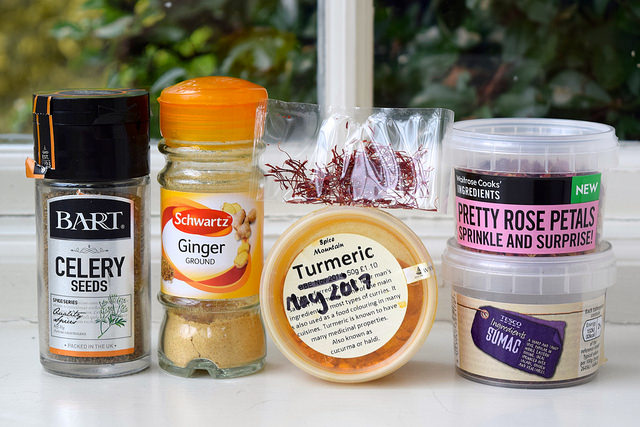
Finally, a few miscellaneous items. Celery seeds really make raw cut tomatoes sing, and are a typical seasoning for a Bloody Mary. While I’m big on fresh ginger for Asian cooking, I love the gentle warmth it adds to baking. I use to to make a gentle ginger sponge when I want to go to town on some brighter icings and fillings, and along with ground turmeric I use it to add a little bit of a kick to my Barbecue Turmeric Chicken Thighs.
Ground turmeric. Along with ground cumin and chilli powder, one of the golden trio of spices in my kitchen. I love it’s brilliant yellow colour, warmth and totally unique, indescribable depth of flavour it adds to so many dishes. Fresh root is messy and hard to get hold of, so to me ground is king. It’s also known as ‘poor man’s saffron’, adding a beautiful yellow where saffron is not available. I have balanced a few threads of saffron on top though (use them to add a bit of a curious, exotic flavour to infused milky puddings, but sparingly both on flavour and price), and I use both together in my Skinny Tomato & Turmeric Cod with Cauliflower Rice.
Finishing up in the Middle East, we have dried rose petals (think Morocco and Istanbul, great for teas, decorations, baking and spice mixes), and sumac. Sumac is dried, ground powder made from sumac berries, and it is beautifully tart and lemony. For me, it is all about the marinades (such as in this Oven-Roasted Chicken with Sumac), but it also adds a beautiful brightness scattered over an olive oil dressed salad.

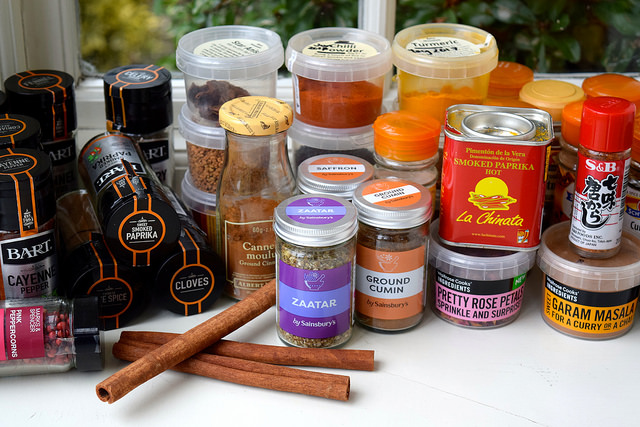
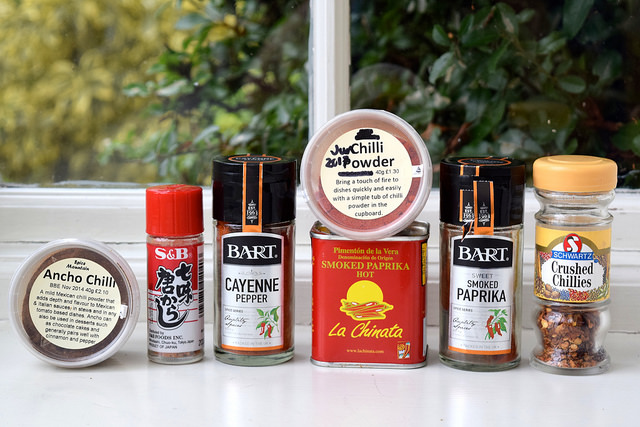

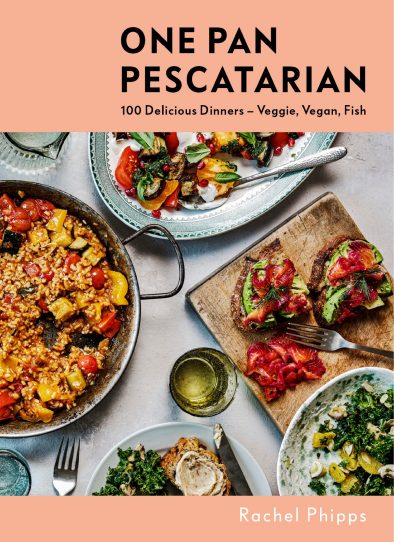
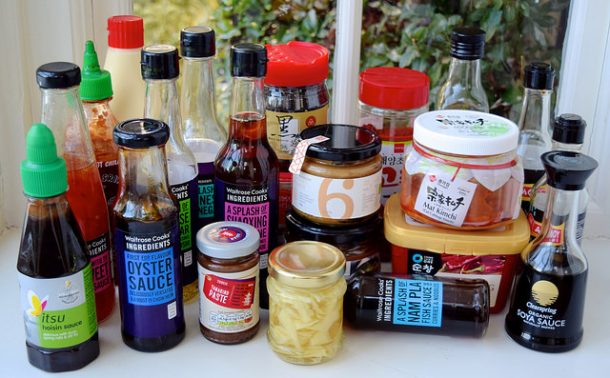
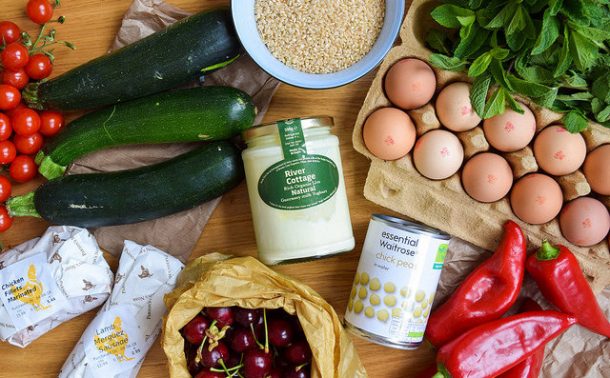
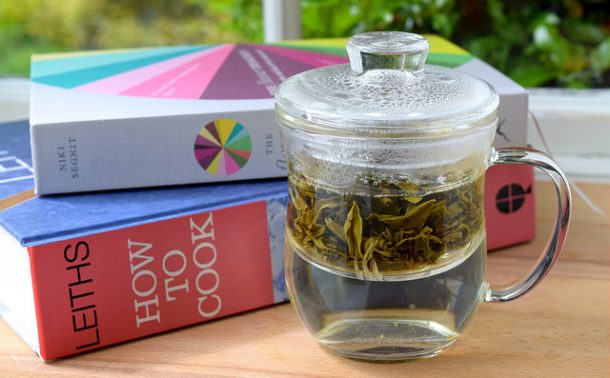
Discussion